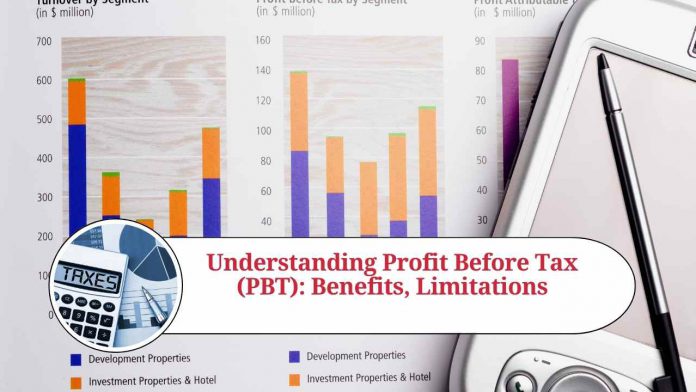Understanding Profit Before Tax (PBT): A Comprehensive Guide
Profit before tax (PBT) is a financial metric that represents the earnings of a company before accounting for income taxes. It is a crucial financial indicator that provides valuable insights into a company’s profitability and financial health. In this blog, we’ll take a deep dive into what PBT is, how it’s calculated, and why it matters.
What is Profit Before Tax (PBT)?
Profit before tax (PBT) is a financial metric that represents a company’s earnings before it pays income taxes. In other words, PBT is the amount of money a company earns before it deducts any taxes from its revenue.
Calculating PBT
PBT is calculated by subtracting all expenses from a company’s revenue except for taxes. This means that PBT is equal to revenue minus cost of goods sold (COGS), operating expenses, and any other expenses except for taxes. The formula for calculating PBT is as follows:
PBT = Revenue – COGS – Operating Expenses – Other Expenses
Why is PBT Important?
PBT is an essential financial metric for businesses because it provides a clear picture of a company’s profitability before taxes. This helps investors, creditors, and other stakeholders to evaluate a company’s financial performance and make informed decisions about investing or lending money.
PBT is also important for tax planning purposes. By understanding their PBT, companies can estimate their tax liability and plan accordingly.
PBT vs. Net Income
PBT is often confused with net income, but the two are different financial metrics. PBT represents a company’s earnings before taxes, while net income represents a company’s earnings after taxes.
Net income is calculated by subtracting all expenses, including taxes, from a company’s revenue. This means that net income is equal to revenue minus COGS, operating expenses, other expenses, and taxes. The formula for calculating net income is as follows:
Net Income = Revenue – COGS – Operating Expenses – Other Expenses – Taxes
While PBT provides a clear picture of a company’s profitability before taxes, net income is a more accurate representation of a company’s profitability after taxes.
Benefits of using PBT
- Reflects business efficiency
PBT is a useful metric for investors to evaluate a company’s efficiency in generating profits. As PBT excludes tax expenses, it can be useful for comparing companies in different jurisdictions or tax brackets.
- Provides tax planning insights
Calculating PBT can help companies estimate their tax liabilities, which can help in tax planning. By knowing their PBT, companies can estimate the taxes they owe and can plan to reduce their tax liability by optimizing their expenses or seeking tax credits.
- Highlights operational efficiency
PBT is an indicator of a company’s operational efficiency as it shows how well a company is managing its expenses, cost of goods sold, and operating expenses. If a company’s PBT is increasing over time, it indicates that the company is becoming more efficient in managing its operations.
- Helps investors evaluate profitability
Investors often use PBT to evaluate a company’s profitability before accounting for taxes. By looking at PBT, investors can get an idea of a company’s financial health and can compare its profitability to other companies in the same industry.
- Can be used for performance evaluation
PBT can be used by management to evaluate the performance of different business units or divisions. By comparing the PBT of different units, managers can identify which units are contributing the most to the company’s profitability and which units need to improve their efficiency.
Limitations of using PBT
- Ignores taxes
While PBT can be useful for tax planning, it doesn’t give a complete picture of a company’s profitability as it ignores taxes. Taxes are a significant expense for most companies and can have a significant impact on a company’s bottom line.
- Not comparable between companies
As PBT does not take taxes into account, it can be challenging to compare the PBT of different companies in different tax brackets or jurisdictions. This can make it difficult for investors to evaluate companies in different regions or countries.
- Doesn’t account for non-operating expenses
PBT doesn’t account for non-operating expenses such as interest on debt or investment income. These expenses can have a significant impact on a company’s profitability, and their exclusion from PBT can give an incomplete picture of a company’s financial health.
Conclusion
Profit before tax (PBT) is a useful financial metric for evaluating a company’s profitability before accounting for taxes. While it has its limitations, PBT provides valuable insights into a company’s operational efficiency and financial health. By understanding PBT, investors, creditors, and managers can make informed decisions and plan for the future.
Read more useful content:
Frequently Asked Questions (FAQs)
- What is profit before tax (PBT)?
Profit before tax (PBT) is a financial metric that represents a company’s earnings before it pays income taxes. It is calculated by subtracting all expenses from a company’s revenue except for taxes.
- How is PBT calculated?
PBT is calculated by subtracting all expenses from a company’s revenue except for taxes. The formula for calculating PBT is as follows: PBT = Revenue – COGS – Operating Expenses – Other Expenses.
- Why is PBT important?
PBT is an important financial metric for businesses because it provides a clear picture of a company’s profitability before taxes. This helps investors, creditors, and other stakeholders to evaluate a company’s financial performance and make informed decisions about investing or lending money.
- What is the difference between PBT and net income?
PBT represents a company’s earnings before taxes, while net income represents a company’s earnings after taxes. Net income is calculated by subtracting all expenses, including taxes, from a company’s revenue.
- How can PBT be used for tax planning?
Calculating PBT can help companies estimate their tax liabilities, which can help in tax planning. By knowing their PBT, companies can estimate the taxes they owe and can plan to reduce their tax liability by optimizing their expenses or seeking tax credits.
- Is PBT a measure of a company’s cash flow?
No, PBT is not a measure of a company’s cash flow. It only represents a company’s earnings before taxes.
- Can PBT be negative?
Yes, PBT can be negative if a company’s expenses are greater than its revenue.
- How can investors use PBT to evaluate a company’s financial health?
Investors can use PBT to evaluate a company’s profitability before accounting for taxes. By looking at PBT, investors can get an idea of a company’s financial health and can compare its profitability to other companies in the same industry.
- Can PBT be used for performance evaluation?
Yes, PBT can be used by management to evaluate the performance of different business units or divisions. By comparing the PBT of different units, managers can identify which units are contributing the most to the company’s profitability and which units need to improve their efficiency.
- What are the limitations of using PBT?
The limitations of using PBT include its exclusion of taxes, its limited comparability between companies in different tax brackets or jurisdictions, and its exclusion of non-operating expenses such as interest on debt or investment income.




















